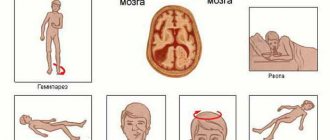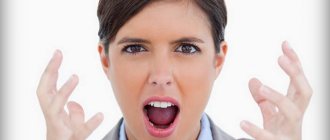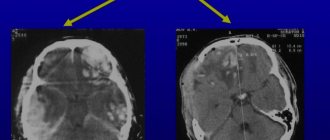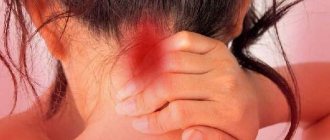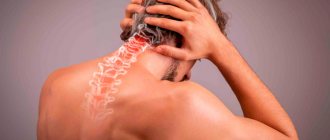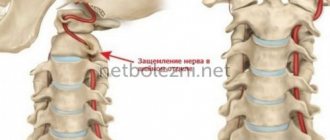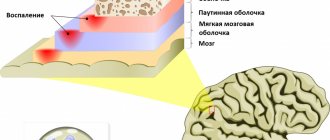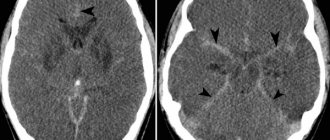Types of tumors on the head and their signs
Hemangioma
A large growth on the head that occurs when the circulatory system is disrupted. The veins can grow uncontrollably, resulting in a red lump. Under the tubercle you can see a network of blood vessels. Doctors consider hemangioma the most dangerous type of tumor.
It is the hemangioma that leads to disruption and formation of the surrounding tissues of the head. Often this type of tumor is located under the hair. A small hemangioma can grow in size over time and become a malignant tumor. If a hemangioma emerges, you must seek specialized medical help.
Allergic reaction
A bump on the head occurs when the human body is exposed to certain allergens. An allergic reaction is caused by food, household chemicals or cosmetics. Such bumps itch and bring a lot of unpleasant sensations to a person. To avoid the formation of such bumps, you should optimize your diet and buy products only from trusted manufacturers.
Fibroma and sarcofibroma
Fibroma is a benign tumor. It consists of connective tissues of the scalp. Fibroids appear on the back of the head, forehead and other parts of the body. In an adult, the tumor can reach significant sizes. The main factors that provoke the occurrence of fibroids: heredity, diabetes or hormonal imbalance. Fibrosarcoma has similar causes, but is a malignant tumor. If left untreated, it leads to death. Most often, fibroma is hard to the touch and does not cause pain to a person.
Lipoma on the head
Lipomas form on damaged human fatty tissues. These are benign tumors. Women over 30 years of age are susceptible to developing growths. Frequent changes in hormonal levels and impaired fat metabolism lead to the formation of lipomas. Such tumors develop both on the head and on other parts of the body. The lipoma is round in shape and soft to the touch. It can be detected in the hair on the back of the head.
Pimples and bites
A person can detect the presence of a lump if it is bothersome and itchy. It could be a bite or acne. Occurs due to poor hygiene or inflammation of the scalp. It does not require specialized medical treatment and goes away on its own within a few days. To speed up healing, you can use compresses or creams.
Bruise or injury
The human body is often susceptible to various types of bruises. And the head is no exception. With a severe bruise, a tubercle forms, which is very painful when touched. This lump is distinguished by its red color and swelling. Heals on average within a few days. If the headache does not go away, you should visit a specialist. This will help rule out traumatic brain injuries.
A wart is a benign tumor that reaches a significant size. This brings a person a lot of unpleasant sensations, in particular due to appearance. The main factors that provoke the development of warts: hormonal imbalance, inflammation and mechanical damage. Warts, in addition to their slow growth, are capable of multiplying and occupying a significant part of the skin. The cone itself resembles a small brown ball. It's not painful. The wart is constantly growing and reaches 0.5 cm in diameter.
Atheroma on the head
Atheroma is growths on the skin. They occur at any age. Both men and women suffer from this disease. It occurs due to blockage and obstruction of the sebaceous glands on the head. Atheroma has a convex and smooth surface, most often yellow. If atheromas are not removed, they hurt and cause discomfort. Lipoma and atheroma are very similar in appearance, so only a doctor can make an accurate diagnosis after diagnosis.
Wen on the head
A lump on the head is a hard, round tumor. Wen forms over the human skin. Fatty spots occur due to hormonal imbalances and frequent stressful situations. They usually have a non-infectious etiology. If the wen interferes with a comfortable life (clings to clothing), it is removed. Removal takes place in a hospital under the supervision of a doctor.
Childhood is a wonderful time, you can play and fool around, ride a bike and climb trees. Of course, most fun games don't come without bruises, scrapes and bumps. What to do if a child falls and hits his head? Or you found a bump on the head, but the baby did not fall. Should I worry and when should I consult a doctor?
How to make a volumetric bun?
There are different types of buns, and similarly several ways to lay them. Before you make a beautiful bun on your head, you need to decide on its location, height, and desired volume. If you have a lot of your own hair, you can do without a donut or its substitutes. Otherwise, it is better to purchase this hairdressing accessory. The color of the device should be close to the shade of the curls.
How to make a voluminous bun without a donut?
Thick or curly strands can be pulled into a bun using just an elastic band and a few bobby pins. A voluminous bun will be achieved by backcombing, applying foam or mousse, but it is easier to twist it loosely or carelessly and fix it with varnish. There are dozens of ways to create a bun without a donut and similar devices.
The easiest and fastest way to make a bun on your head:
- Tie a high ponytail and secure it with an elastic band.
- Twist your hair into a rope that is not too tight.
- Wrap it around the base of the ponytail once and secure with bobby pins.
- Wrap the ends with an elastic band and secure with bobby pins. Straighten the tourniquet with your fingers.
https://youtube.com/watch?v=UU7Ww6ICVeQ%250D
How to make a voluminous bun with a donut?
Thin and not very thick hair is difficult to form into a lush and airy bun. Knowing how to make a bun on your head without a donut, a hairstyle using accessories that add volume will not cause any difficulties.
The fastest and easiest way:
- Tie a tight ponytail. Thread it through the donut, placing the device at the base of the elastic band.
- Distribute the hair around the perimeter of the accessory, completely covering it with curls.
- Secure the resulting bun with hairpins and bobby pins.
https://youtube.com/watch?v=hvZSGvFl-Zw%250D
There are bagels made from different materials, sizes and diameters. If you don’t have this hairdressing device at hand, you can replace it with a T-shirt sleeve, a sock (with the end cut off), or another hair clip:
- twister;
- heagami;
- sophist twist;
- bumpit.
Volume bun for short hair
The minimum length to create a bun is to the middle of the neck. Any haircut with strands shorter than the specified level does not allow the bun to be twisted. The location of the styling depends on the length, but the optimal hairstyle would be at the base of the neck or a bun just below the back of the head. You won't be able to use a bagel or similar accessories either, so you'll have to comb your curls a little before making a voluminous bun for short hair.
There are two successful options for creating a bun in this case:
- Tie a low ponytail and twist a loose, messy bun around the base, securing it with a pair of bobby pins.
- Comb your hair back. Tie the elastic band 2-3 cm above the ends, do not roll it too much and secure it at the base of the neck.
Volume bun for medium hair
Curls just below the shoulders are a convenient length for creating the described style. You can do a careless high volume bun, and side and low versions of the bun. If the strands are thin, it is better to use a donut or a twister hairpin to make the styling more voluminous. A voluminous bun hairstyle on medium hair will look impressive if it is first curled or crimped.
A bun with different decor looks similarly good:
- braids and small plaits;
- thin and wide satin ribbons;
- stilettos with pearls or artificial stones;
- rim;
- flowers;
- tiara;
- a bright scarf and other accessories.
Volume bun for long hair
Women with curls below the shoulder blades can afford any type of styling presented. In everyday life, a simple messy bun for long hair, with a few loose strands, is suitable. This hairstyle looks romantic, gentle and homely. For special occasions, you can create a neat but voluminous bun for long hair, decorating it with braids, plaits, curls or suitable accessories.
For an elegant and elegant holiday hairstyle, stylists recommend a low bun:
- Curl your hair with curling irons or curling irons.
- Gather a side ponytail at the base of the neck.
- Put on a small bagel.
- Form a not too tight bun around it, leaving structural curls.
- Secure the resulting styling with pins and bobby pins.
- Release a few loose curls.
- Spray your hair with hairspray.
- Decorate the voluminous bun with a small hairpin with rhinestones or ceramic flowers, a bright satin ribbon, and a bow.
Carbuncle on the head
A carbuncle (“carbuncle”) is a necrotic inflammation of several boils fused together. The disease is a complication of furunculosis. The process involves the deep layers of the skin and subcutaneous fat. The skin becomes blue-purple. Several necrotic foci appear in the center. After they are opened and the dead tissue is rejected, the inflammation subsides and a disfiguring scar is formed.
With a carbuncle, especially when localized on the head, the condition of patients can be very serious, accompanied by fever and confusion. In severe cases, the disease can be fatal. Treatment is the same as for furunculosis.
Wen on the head: how to get rid of it with a laser
In addition to surgery, you can effectively remove a wen on the head using a laser. This method is performed under local anesthesia and is aimed at destroying the fat capsule. To implement it, you do not need to shave your hair. The operation takes only 25 minutes. After its implementation, relapse of the disease is practically zero.
A small wound is formed at the site of the wen removed by the laser. As a rule, it heals completely within a week. After this procedure, virtually no traces remain on the skin. Laser removal of the wen is especially recommended if it is localized on the eyelids.
When to see a doctor
Sores on the head in the hair require competent consultation with a specialist. Only a doctor can determine the cause of the pathology. If you have a problem with the scalp, you should contact a trichologist. The doctor will conduct appropriate studies and prescribe a treatment regimen.
You should contact a trichologist in the following cases:
- excessive hair loss;
- the appearance of coarse hair;
- excessive oily scalp;
- hair gluing;
- dry skin;
- peeling;
- a feeling of tightness and discomfort in the scalp;
- redness;
- the appearance of oval or round plaques;
- itching
Treatment
Treatment for the resulting lumps depends on the type and cause.
First aid for injury is to apply a cold compress to the injury site (frozen foods are often used for this). Keep for about 10 minutes. Preparations in the form of ointments and gels are also used:
- Troxevasin – strengthens vascular walls, relieves swelling. Rub in gently twice a day.
- Troxerutin - effectively eliminates swelling; it is forbidden to apply to injuries where the integrity of the skin is compromised.
- Heparin ointment - relieves pain and resolves blood clots.
- Rescuer - antiseptic effect.
If insect bites occur, treat with soap and cold; if symptoms persist, use anti-allergenic agents. If necessary, consult an allergist or dermatologist.
For lipoma, self-treatment is not carried out; the help of a surgeon is required. Most often it is removed surgically, with a laser, or using a special substance that resolves fat (injected into the wen itself).
For atheroma, the use of various ointments and folk remedies turns out to be ineffective; they are best used for faster healing after removal or self-opening of the tumor. Removal of atheroma is carried out surgically, laser and radio wave methods.
On this topic
Treatment for fibroids is primarily aimed at eliminating the cause. Next, the tumor is removed using a laser, surgery, cryodestruction (using low temperatures) or radio wave method.
There are several ways to remove a hemangioma:
- Application of liquid nitrogen (no traces are left).
- Microwave cryodestruction – for deep facial tumor localization.
- Radiation therapy – for damage near the eye.
Therapy is carried out exclusively under the supervision of a doctor, since the risk of transformation into a malignant tumor is high.
The boil is removed by a surgeon on an outpatient basis, after which antibacterial and physical therapy is prescribed.
The most effective way to remove a wart is to remove:
- Current therapy is not the most effective method; several sessions are often necessary.
- Freezing with nitrogen is expensive and the surgery leaves visible scars. Long-term postoperative care is also necessary.
- Laser burning is the most widely used procedure and is carried out quickly. No traces remain and similar neoplasms no longer appear.
- Surgical intervention.
Osteoma
Symptoms of osteoma, depending on its location:
- upper jaw: headaches, sore throat, impaired motor activity of the mouth, nosebleeds;
- lacrimal and ethmoid bones: visual disturbances, foreign body sensations, displacement of the eyeball.
If the osteoma does not increase and does not have symptoms, it is not necessary to treat it.
Otherwise it is deleted:
- Surgically. The neoplasm is excised along with the periosteum and part of the healthy tissue. This method is used if the osteoma grows rapidly and has a negative effect on neighboring organs.
- Laser evaporation. Excision of damaged tissue with a laser beam. Used for small osteomas.
Secondary osteoma is rare.
This type of disease is another type of tumor. If you look at medical photographs (x-rays), you will see that the tumor forms on the bone. The swelling is very dense to the touch. However, no matter how frightening it may look, it does not pose any danger to the patient. When formed, it does not itch or hurt, and a person does not feel any discomfort on the head.
As a rule, these types of tumors on the head appear in children and adolescents in the age group from 4 years to 21 years. There are two development options:
- When you press on this growth, painful sensations will occur.
- An option with a painless development of the situation is also possible.
It is worth remembering that if the types of lumps that appear cause even minor pain, then you need to consult a doctor
Warts
They can be located in the form of bumps on the forehead above the eyebrows and not only, causing unpleasant sensations to the person. However, they do not cause any pain. Quite a lot of warts form over a person’s entire life, and they do not have to be removed.
The exception is the occurrence of various infections. The reason why warts appear is infection with the human papillomavirus. They are capable of growing and reaching a size of 0.5 cm. For warts on the head under the hair, treatment will consist of several stages, the implementation of which guarantees getting rid of the bumps on the head.
First, a sick person should consult a dermatologist, who will prescribe a histological examination, as well as dermatoscopy. Then a medicinal course of treatment will be prescribed, including antiviral drugs of general and local action. In some cases, laser wart removal is used.
Who is it suitable for?
To say that it suits everyone means to deceive. First of all, you should like this hairstyle and match your inner style. You must feel comfortable, otherwise it will not add either beauty or a smile to your face.
If the lines of your neck are far from ideal, then there is no reason to be upset either.
A low bun “A la Carmen” delicately distracts from the neck line and adds sexuality.
Girls who are too tall should not have a high bump on their head; it is better to make it lower, with the addition of curls and accessories.
Another little tip, but not a rule. Women of advanced age should avoid a low bun. In their case, such a hairstyle can only add a couple of years to you. Although everything is individual.
Causes
The reasons for the appearance of cones are varied, so they can be divided into several separate groups:
- bumps after injury. Impact or bruise of soft tissues is the most common factor in the development of a tumor. As a result, swelling forms, and the bruised area is very painful. As a rule, such bumps go away on their own without serious treatment. Cold compresses and applying heated cabbage leaves will help speed up the recovery process. Also in such a situation, iodine in the form of a grid is effective. Relevant for injuries to the forehead and back of the head. If tumors form, you should consult a doctor in order to exclude the possibility of traumatic brain injury;
- bump from a bite. Small swellings on the forehead, head, and body can occur as a result of an insect bite. This is an allergic reaction to the saliva secreted by the parasite. As a rule, you can see a small point on the surface through which the poison penetrates. The diameter of the affected tissue can reach 2-3 cm. Such bumps go away on their own or after using antihistamines. They are very itchy and have a dense consistency;
- lump in the form of a subcutaneous formation. Such tumors do not respond to standard treatment and slowly increase in size. Such growths include atheromas, lipomas, fibromas, hemangiomas, and warts.
Diagnostics
Each head tumor is diagnosed differently.
Pituitary microadenoma
Pituitary microadenoma is a benign neoplasm that consists of glandular tissues of the organ.
For traumatic brain injury, X-rays, MRI and CT are used, and angiography is often performed (examination of brain vessels with the administration of contrast agents).
Insect bites are diagnosed based on clinical manifestations. Treated by an allergist.
Confirmation of atheroma begins with examination and palpation of the atheroma itself and nearby lymph nodes. Next, Doppler ultrasound, ultrasound of the cyst, CT scan, and head x-ray are prescribed. The most accurate method is histological examination.
Hemangioma is diagnosed in the following ways:
- general blood
- Ultrasound of the brain.
- Endoscopic studies.
- Magnetic resonance imaging.
- Multislice computed tomography.
A fibroid is examined by a doctor. Additionally, histological and cytological tests are prescribed.
Diagnosis of hemangioma is carried out by a dermatologist. For this purpose, ultrasound, biopsy and cytological examination are prescribed.
Confirming the presence of warts involves scraping and examining them using a microscope. If a malignant tumor is suspected, a biopsy is prescribed.
Warts
These are benign formations on the skin, consisting of connective tissue and covered with epithelium. Warts appear on any part of a person’s skin, including on the head. Doctors distinguish several types of wart bumps in humans: regular, flat, plantar, senile and pointed. The cause of warts in humans is infection with the papilloma virus, which can be transmitted through household contact, as well as through contact with an infected person. After infection and the first appearance of a wart bump on the skin, a long time may pass. If one wart appears on the skin, then in this case the patient should be very careful with it so as not to damage it, otherwise this virus can be spread throughout the body. There are many different methods for treating warts with folk remedies, using compresses, ointments and various tinctures, however, before using them, you must first consult with a specialist, as this can significantly harm your body. Traditional medicine to remove a bump on the head involves the use of methods such as surgery, radio wave therapy or laser removal. The doctor himself determines which method to choose.
When a bump appears on your head, you should not despair, especially since it is not painful. And the first thing to do is visit the doctor's office in order to rule out serious diseases and, if necessary, receive appropriate treatment.
A bump on the head may be the result of a blow. It usually doesn’t hurt and doesn’t cause much discomfort. However, its appearance is not always so harmless. If the lump is suspicious, very painful, swollen, and even the temperature has risen, and is localized on the back of the head or on the sides of the skull, then it is still worth identifying the cause of its appearance. A lump may appear as a symptom of a neoplasm or other pathology in the body that requires diagnosis and treatment, possibly even surgery.
A bump on the head can appear as a result of external trauma: from a bruise or an insect bite, or internal: from a lipoma in the form of a wen, osteoma, furunculosis, kateroma (cyst formation), trichoepithelioma, enlarged lymph nodes.
- Injury. The lump appears on the head in the form of a hematoma with an accumulation of blood under the skin, hurts on palpation, and takes on a lilac or eggplant hue. It is necessary to treat, open surgically, clean the wound from accumulated blood and possibly pus.
- Mosquito, bee or wasp bite. Swelling on the head, burning sensation, pain, itching, and fever may occur. Treatment consists of treating the affected areas, washing with antiseptics, and applying antiallergic ointments (gels). You can't scratch the bump. It is better to immediately go to the emergency room for help, especially if the temperature rises and severe itching overcomes.
- Atheroma in the form of a neoplasm localized on the head due to insufficient outflow of the secretion of the sebaceous glands, their blockage, and the accumulation of a dense consistency under the skin. Requires surgical removal and examination of the material for histology. Usually this is a benign cyst of origin.
- Lipoma in the form of a wen, a benign tumor of dense consistency. Usually the lump does not hurt and does not cause much discomfort. Localizes the forehead and scalp. Appears as a result of metabolic failure and pathology of adipose tissue. It is hereditary in origin and can degenerate into liposarcoma, a malignant neoplasm that requires removal by laser, cryodestruction or surgery.
- Trichoepithelioma is a benign tumor on the head that is usually hereditary. It can be grouped in the form of dome-shaped numerous small elements on the head up to 6 mm in diameter, growing over time, usually not painful on palpation. Treatment involves surgery or electrocoagulation.
- Osteoma in the form of a benign cyst with slow growth, but not capable of degenerating into a malignant form, metastasizing, or growing into nearby tissues. The lump hurts, but sometimes it is not felt at all. Smooth to the touch, slightly raised above the bone tissue in the shape of a ball with smooth edges. The cause of the appearance may be heredity, injury, a number of diseases: gout, rheumatism, syphilis. It must be removed by cutting off nearby healthy areas of bone tissue.
How to get rid of acne on your head
- You can get rid of acne on your head through treatment. To do this, you need to consult a trichologist, who, after diagnosis, will prescribe a treatment that is suitable for you.
- Pimples can disappear if the underlying disease causing their appearance is eliminated: for example, stomach problems, etc.
- Folk remedies: solarium (dries out the skin, reduces the production of sebaceous glands); homemade hair masks and shampoos.
Traditional recipes for getting rid of acne on the head
This problem needs to be approached comprehensively. In addition to the individually selected medications that your doctor will prescribe for you, based on the test results, you should also turn to traditional medicine. These recipes have been collected by our grandmothers for many years. They relieve itching well and eliminate purulent inflammation.
It has antiseptic properties. This product should be used no more than 4 times a month. We buy colorless henna for hair in a specialized store and pour it into a shallow bowl. Fill with one glass of hot water, it should be no more than 70 degrees. Let it sit for several hours. Then add one chicken egg and mix well until smooth. Apply the product to the scalp and leave the product on for about 30 minutes. Next, rinse your hair and head well, you can use shampoo.
Tincture of calendula
This product can be easily purchased at any pharmacy, and it is inexpensive. It has the ability to normalize the functioning of the sebaceous glands. To prepare the solution, take 2 tbsp. tinctures and mix with 250 grams of water, blot a cotton pad and wipe the scalp 2 times a week.
Tea tree oil
Has antibacterial and antiseptic properties. To solve such an unpleasant problem as acne, you just need to add a couple of drops of this product to your shampoo.
Aloe juice
This remedy has anti-inflammatory, antibacterial and wound-healing properties. We cut off the lower and thick leaves of this plant. They contain a large amount of juice. Squeeze the juice out of them and apply to the scalp. After this, you need to put on a hat and wrap your head in a towel. After half an hour you can wash it off.
Apple vinegar
The solution should be diluted in advance: 100 ml of vinegar per 100 ml of water. First, wash your hair with shampoo and then rinse with the prepared product. After 5 minutes, rinse your hair well with water without using shampoo. This will avoid an unpleasant odor.
This soap can be found at a pharmacy or in the hardware department of any supermarket. It is also available in liquid form, but this product costs much more (about 150 rubles).
Honey and cinnamon mask
Preparing such a remedy will not be difficult. Take 2 tbsp. honey and 1 tsp. cinnamon, mix well. Apply the resulting product to problem areas or the entire head. You can wash off the mask after 30 minutes.
Strawberry juice
Only freshly squeezed juice is suitable. It cleanses the scalp well. This juice destroys many pathogenic bacteria and also heals wounds. It contains a large number of vitamins and microelements. Periodically you need to lubricate the affected areas of the head.
Anise
Perhaps the most valuable part is the seeds. They contain a large amount of vitamins and minerals. This plant has analgesic, antiseptic and anti-inflammatory properties. Anise fruits can be purchased at the pharmacy. They should be filled with warm water and left to swell overnight. In the morning, grind the seeds into a paste. We apply it to the affected areas of the scalp. Leave it on for about an hour and then wash it off. This mask can be done 3 times a week.
Salt baths
There is one BUT in this method! If previously such a composition contained only natural ingredients, now it contains many artificial additives, so it can be used for no more than 2 weeks. We purchase a special composition and take a bath with it every day.
As you can see, there are a lot of folk and cosmic remedies for combating rashes, but the main task is to identify the cause of their appearance. In the presence of gastrointestinal diseases, folk remedies and space remedies will not be effective.
Elegant DIY bump hairstyle
Recently, the bump hairstyle, which not everyone can do on their own, has become very popular. Every year style, fashion, hairstyles are improving. Short bangs, voluminous curls, ponytail - the abundance of hairstyle options is amazing. But there are also styles that never go out of fashion and are still popular today. There were times when we were touched by my grandmother’s efforts to make the so-called Babette on her head using a foam roller. It seemed that such methods of creating hairstyles had sunk into oblivion. Now every second girl knows what a “bagel” is and how to use such an accessory to create an elegant bun hairstyle.
Features of this hairstyle
This installation has quite a rich history. At all times, this hairstyle was in great demand and was present in almost all images and styles of women's fashion. The ancestor of the cone was an ordinary bun, when all the hair was gathered into one ponytail on the top of the head, twisted into a rope and secured with hairpins. Afterwards, many subtypes of this hair styling technique appeared - French bun, Shell, Babette hairstyles, etc. Nowadays, the hairstyle in the form of a cone is very popular.
The image of a society lady or an eccentric girl can be created thanks to such a newfangled hairstyle. What distinguishes it from other styles is its versatility; this option can suit absolutely everyone: both little girls for a kindergarten graduation, and an adult lady for a celebration, as well as any style - from sporty to elegant. The only difference is in the technique of creating the image on the head.
Making a beautiful hairstyle yourself is not difficult. The only thing that can become an obstacle is a very short haircut. To create, you will need an elastic band, hairpins, a donut, and a comb. By the way, the donut accessory can be replaced with an elastic band made by yourself from an ordinary sock.
Step-by-step description of the process
The bump hairstyle begins with combing the hair. To create the perfect look, it is better to have clean hair. Although, if you need styling for going to the gym or for a trip to the country, washing your hair is not necessary.
We collect all the hair on the back of the head into one ponytail and secure it with a thick elastic band. The location of the tail may vary, which again depends on the purpose of using this styling. For example, if it is a gentle, romantic look, you can make a ponytail that you gather just below the back of your head.
Next, we pass the tail on the head through the “donut” to the base, distribute the hair evenly and secure it with another elastic band. We divide the remaining hair into several strands, twist them into flagella and hide them under the resulting bump, securing them with hairpins. You don’t have to use the elastic band a second time, but initially, by threading the tail through the “donut”, as if wrapping your hair around this accessory. When finished, secure everything with pins.
The base for the “Bump” styling is ready. Then everything depends on your imagination and skill. For a more voluminous hairstyle, you can try to slightly pull out the strands from the resulting bun. The hair itself can be slightly disheveled at the roots. The main thing is not to overdo it and remember to seal everything with varnish.
You can style your hair with braids - from strands that are not twisted into strands, you can braid them and elegantly lay them around the bun.
Then secure with bobby pins or hairpins. Recently, when creating such a masterpiece as a bump hairstyle, it has become fashionable to braid a regular braid in the opposite direction, i.e. from the neck to the back of the head, then connect it to the main ponytail and then put it into a modern bun using the technique described above.
Or you can completely refuse to use the “donut”. Taking all the hair into a ponytail, divide it into strands, carefully lay each one around the base and secure with a bobby pin.
You can complement this style with anything: a headband, a beautiful hairpin, openwork pins and bobby pins, a ribbon, a scarf, etc. The main thing is to observe moderation and style in everything.
Symptoms
Symptoms are determined depending on the type of formation.
Injury
Painful sensations appear when pressed, redness and swelling occur. With more serious injuries, which indicate a closed craniocerebral injury, the following symptoms occur:
- Loss of consciousness occurs immediately after the injury. At this time, the patient does not respond to external stimuli and does not feel pain.
- Pain in different parts of the head - begins immediately after regaining consciousness.
- Nausea and vomiting do not give a feeling of relief.
- Dizziness.
- Hematoma - most often occurs with fractures of the bone frame of the skull. You can often observe the ear and near the eyes.
- The face and neck become red.
- Amnesia - a person does not remember events that happened before the injury (occasionally there are cases when a person forgets events that happened after the injury).
- Development of convulsive syndrome.
- Increased sweating.


